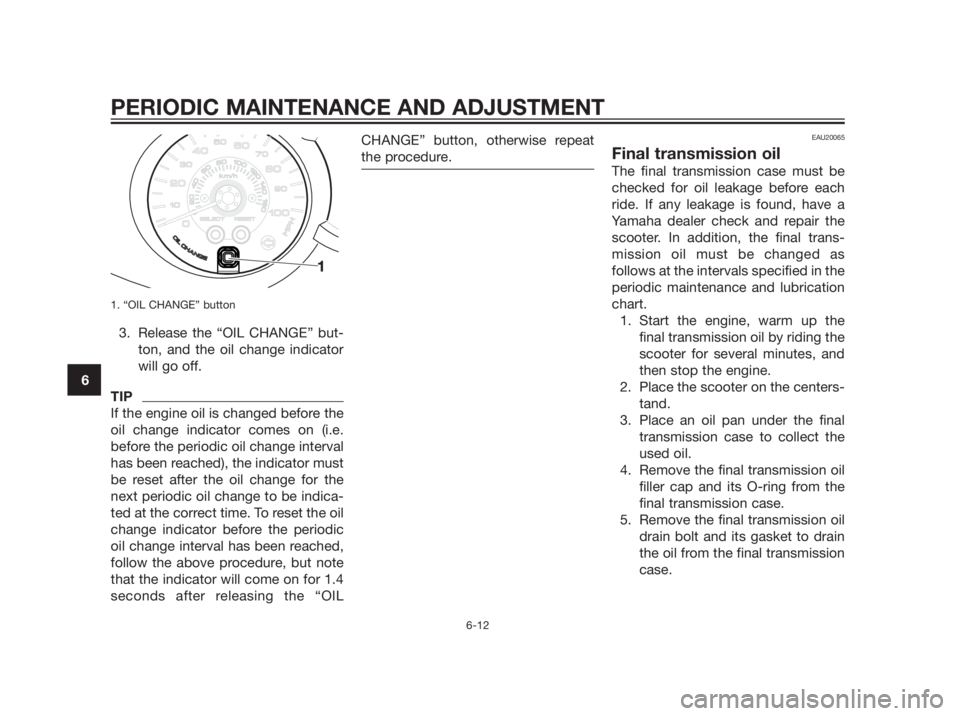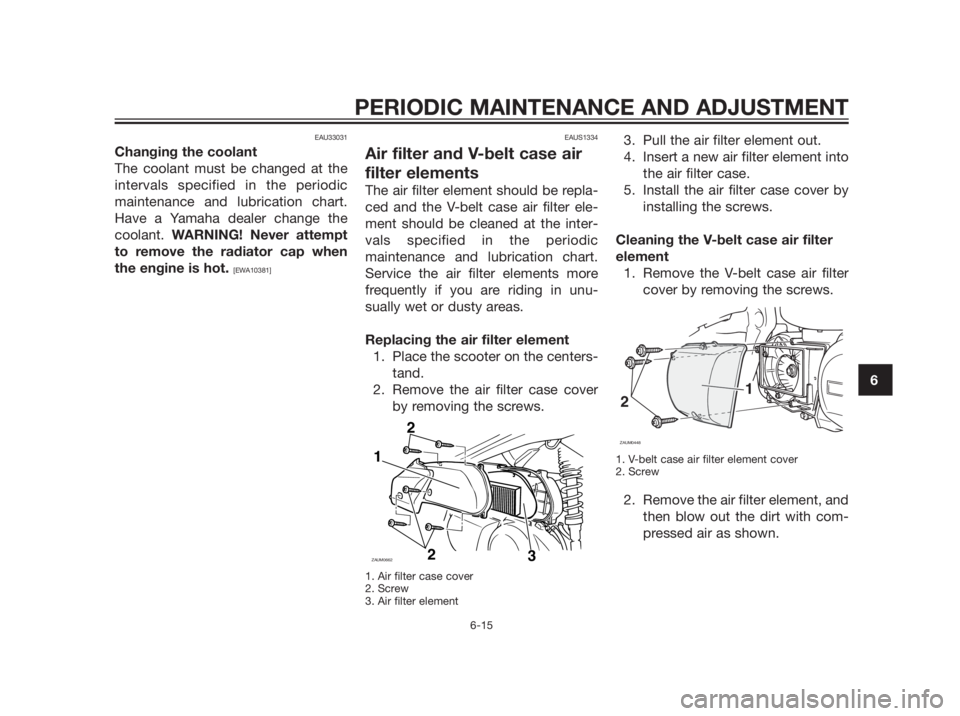Page 58 of 90

1. “OIL CHANGE” button
3. Release the “OIL CHANGE” but-
ton, and the oil change indicator
will go off.
TIP
If the engine oil is changed before the
oil change indicator comes on (i.e.
before the periodic oil change interval
has been reached), the indicator must
be reset after the oil change for the
next periodic oil change to be indica-
ted at the correct time. To reset the oil
change indicator before the periodic
oil change interval has been reached,
follow the above procedure, but note
that the indicator will come on for 1.4
seconds after releasing the “OILCHANGE” button, otherwise repeat
the procedure.
EAU20065
Final transmission oil
The final transmission case must be
checked for oil leakage before each
ride. If any leakage is found, have a
Yamaha dealer check and repair the
scooter. In addition, the final trans-
mission oil must be changed as
follows at the intervals specified in the
periodic maintenance and lubrication
chart.
1. Start the engine, warm up the
final transmission oil by riding the
scooter for several minutes, and
then stop the engine.
2. Place the scooter on the centers-
tand.
3. Place an oil pan under the final
transmission case to collect the
used oil.
4. Remove the final transmission oil
filler cap and its O-ring from the
final transmission case.
5. Remove the final transmission oil
drain bolt and its gasket to drain
the oil from the final transmission
case.
PERIODIC MAINTENANCE AND ADJUSTMENT
6-12
6
Page 59 of 90

1. Final transmission oil filler cap
2. O-ring
6. Install the final transmission oil
drain bolt and its new gasket,
and then tighten the bolt to the
specified torque.
1. Final transmission oil drain bolt
7. Refill with the specified amount
of the recommended final trans-
mission oil. WARNING! Make
sure that no foreign material
enters the final transmission
case. Make sure that no oil
gets on the tire or wheel.
[EWA11311]
8. Install the final transmission oil
filler cap and its new O-ring, and
then tighten the oil filler cap.
9. Check the final transmission case
for oil leakage. If oil is leaking,
check for the cause.
EAU20070
Coolant
The coolant level should be checked
before each ride. In addition, the coo-
lant must be changed at the intervals
specified in the periodic maintenance
and lubrication chart.
EAUS1670
To check the coolant level
1. Place the vehicle on a level surfa-
ce and hold it in an upright posi-
tion.
TIP
�The coolant level must be chec-
ked on a cold engine since the
level varies with engine tempera-
ture.
�Make sure that the vehicle is
positioned straight up when
checking the coolant level. A
slight tilt to the side can result in
a false reading.
2. Check the coolant level through
the check window.
Recommended final transmission
oil:
See page 8-1
Oil quantity:
0.25 L (0.26 US qt, 0.22 Imp.qt)
Tightening torque:
Final transmission oil drain bolt:
PERIODIC MAINTENANCE AND ADJUSTMENT
6-13
6
Page 60 of 90

TIP
The coolant should be between the
minimum and maximum level marks.
1. Maximum level mark
2. Minimum level mark
3. Coolant level check window
3. If the coolant is at or below the
minimum level mark, lift up the
right floorboard mat as shown.
1. Floorboard mat
4. Open the reservoir cap, and then
add coolant to the maximum
level mark. WARNING! Remove
only the coolant reservoir cap.
Never attempt to remove the
radiator cap when the engine is
hot.
[EWA15161]
NOTICE: If coolant is not avai-
lable, use distilled water or soft
tap water instead. Do not use
hard water or salt water since it
is harmful to the engine. If
water has been used instead of
coolant, replace it with coolant
as soon as possible, otherwise
the cooling system will not be
protected against frost andcorrosion. If water has been
added to the coolant, have a
Yamaha dealer check the anti-
freeze content of the coolant
as soon as possible, otherwise
the effectiveness of the coolant
will be reduced.
[ECA10472]
1. Coolant reservoir cap
5. Close the reservoir cap
6. Place the floorboard mat in the
original position and push it
downward to secure it.
Coolant reservoir capacity:
0.25 L (0.26 US qt, 0.22 Imp.qt)
FULL
LOW
PERIODIC MAINTENANCE AND ADJUSTMENT
6-14
6
Page 61 of 90

EAU33031
Changing the coolant
The coolant must be changed at the
intervals specified in the periodic
maintenance and lubrication chart.
Have a Yamaha dealer change the
coolant. WARNING! Never attempt
to remove the radiator cap when
the engine is hot.
[EWA10381]EAUS1334
Air filter and V-belt case air
filter elements
The air filter element should be repla-
ced and the V-belt case air filter ele-
ment should be cleaned at the inter-
vals specified in the periodic
maintenance and lubrication chart.
Service the air filter elements more
frequently if you are riding in unu-
sually wet or dusty areas.
Replacing the air filter element
1. Place the scooter on the centers-
tand.
2. Remove the air filter case cover
by removing the screws.
1. Air filter case cover
2. Screw
3. Air filter element
3. Pull the air filter element out.
4. Insert a new air filter element into
the air filter case.
5. Install the air filter case cover by
installing the screws.
Cleaning the V-belt case air filter
element
1. Remove the V-belt case air filter
cover by removing the screws.
1. V-belt case air filter element cover
2. Screw
2. Remove the air filter element, and
then blow out the dirt with com-
pressed air as shown.
21
ZAUM0448
1
2 2
ZAUM06623
PERIODIC MAINTENANCE AND ADJUSTMENT
6-15
6
Page 62 of 90

1. V-belt case air filter cover
2. V-belt case air filter element
3. Check the air filter element for
damage and replace it if neces-
sary.
4. Install the air filter element with
the colored side facing outward.
NOTICE: Make sure that each
filter element is properly sea-
ted in its case. The engine
should never be operated wit-
hout the filter elements insta-
lled, otherwise the piston(s)
and/or cylinder(s) may become
excessively worn.
[ECA10531]
5. Install the V-belt case air filter
cover by installing the screws.
EAU48431
Adjusting the throttle cable
free play
1. Throttle cable free play
The throttle cable free play should
measure 3.0–5.0 mm (0.12–0.20 in) at
the inner edge of the throttle grip.
Periodically check the throttle cable
free play and, if necessary, adjust it as
follows.
TIP
The engine idling speed must be
correctly adjusted before checking
and adjusting the throttle cable free
play.
1. Slide the rubber cover back.
2. Loosen the locknut.3. To increase the throttle cable free
play, turn the adjusting nut in
direction (a). To decrease the
throttle cable free play, turn the
adjusting nut in direction (b).
1. Rubber cover
2. Locknut
3. Adjusting nut
4. Tighten the locknut and then sli-
de the rubber cover to its original
position.
21
ZAUM0449
PERIODIC MAINTENANCE AND ADJUSTMENT
6-16
6
Page 63 of 90

EAU21401
Valve clearance
The valve clearance changes with
use, resulting in improper air-fuel mix-
ture and/or engine noise. To prevent
this from occurring, the valve clearan-
ce must be adjusted by a Yamaha
dealer at the intervals specified in the
periodic maintenance and lubrication
chart.
EAU21873
Tires
To maximize the performance, durabi-
lity, and safe operation of your vehi-
cle, note the following points regar-
ding the specified tires.
Tire air pressure
The tire air pressure should be chec-
ked and, if necessary, adjusted befo-
re each ride.
EWA10501
Operation of this vehicle with
improper tire pressure may cause
severe injury or death from loss of
control.
�The tire air pressure must be
checked and adjusted on coldtires (i.e., when the temperatu-
re of the tires equals the
ambient temperature).
�The tire air pressure must be
adjusted in accordance with
the riding speed and with the
total weight of rider, passenger,
cargo, and accessories appro-
ved for this model.
Tire air pressure (measured on
cold tires):
0–90 kg (0–198 lb):
Front:
190 kPa (1.90 kgf/cm
2,
28 psi, 1.90 bar)
Rear:
220 kPa (2.20 kgf/cm
2,
32 psi, 2.20 bar)
90 kg - maximum load:
Front:
210 kPa (2.10 kgf/cm
2,
30 psi, 2.10 bar)
Rear:
250 kPa (2.50 kgf/cm
2,
36 psi, 2.50 bar)
Maximum load*:
YP250R 175 kg (386 lb)
YP250RA 171 kg (377 lb))
YP250R Sport 173.5 kg (383 lb)
* Total weight of rider, passenger,
cargo and accessories WARNING
ZAUM0053
PERIODIC MAINTENANCE AND ADJUSTMENT
6-17
6
Page 78 of 90
EAU42701
Troubleshooting charts
Starting problems or poor engine performance
Check the fuel level in
the fuel tank.
1. FuelThere is enough fuel.
There is no fuel.Check the compression.
Supply fuel.
The engine does not start.
Check the compression.
Operate the electric starter.
2. CompressionThere is compression.
There is no compression.Check the ignition.
Have a Yamaha dealer
check the vehicle.
Remove the spark plug
and check the electrodes.
3. IgnitionWipe off with a dry cloth and correct the
spark plug gap, or replace the spark plug.
Have a Yamaha dealer check the vehicle.
The engine does not start.
Have a Yamaha dealer
check the vehicle.
The engine does not start.
Check the battery.
Operate the electric starter.
4. BatteryThe engine turns over
quickly.
The engine turns over
slowly.The battery is good.
Check the battery lead connections,
and charge the battery if necessary.
Dry
WetOperate the electric starter.
PERIODIC MAINTENANCE AND ADJUSTMENT
6-32
6
Page 79 of 90

Engine overheatingEWAT1040
�Do not remove the radiator cap when the engine and radiator are hot. Scalding hot fluid and steam may be
blown out under pressure, which could cause serious injury. Be sure to wait until the engine has cooled.
�Place a thick rag, like a towel, over the radiator cap, and then slowly rotate the cap counterclockwise to the
detent to allow any residual pressure to escape. When the hissing sound has stopped, press down on the
cap while turning it counterclockwise, and then remove the cap.
TIP
If coolant is not available, tap water can be temporarily used instead, provided that it is changed to the recommended
coolant as soon as possible.
Wait until the
engine has cooled.Check the coolant level in the
reservoir and radiator.
The coolant level
is OK.
The coolant level is low.
Check the cooling system
for leakage.
Have a Yamaha dealer checkand repair the cooling system.
Add coolant. (See TIP.)
Start the engine. If the engine overheats again, have a
Yamaha dealer check and repair the cooling system.
There is
leakage.
There is
no leakage.
WARNING
PERIODIC MAINTENANCE AND ADJUSTMENT
6-33
6